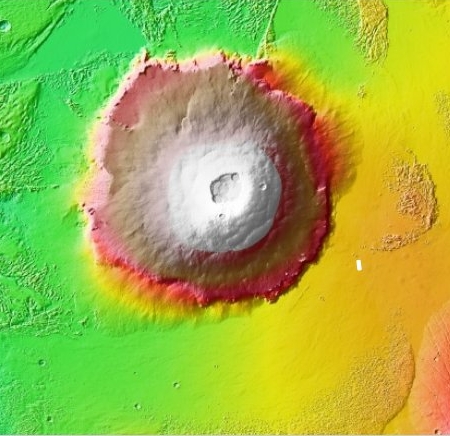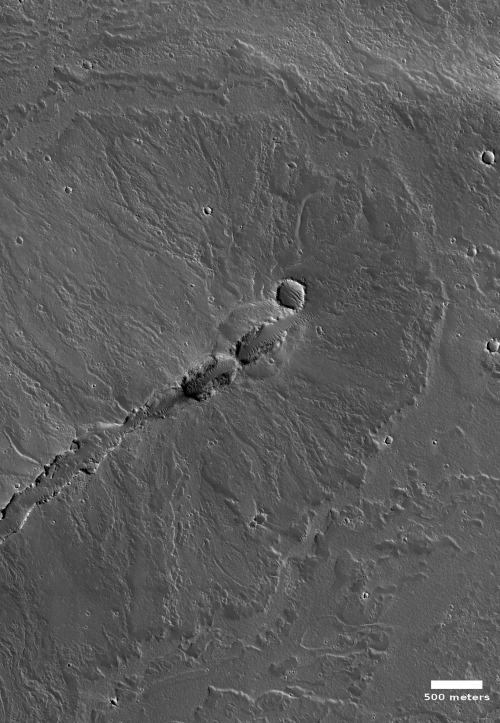Ancient and recent volcanoes on Mars
Cool image time! The photo to the right, rotated, cropped, and reduced to post here, was taken by the high resolution camera on Mars Reconnaissance Orbiter (MRO) on October 25, 2020. It shows what it calls a “possible volcanic vent east of Olympus Mons”.
Is this active? If not, how old is it. Also, the elongated shape of the vent suggests the possibility of a lava tube, or at least some underground complexity to the release of its magma.
In order to get some clarity, I emailed Sarah Sutton of the Lunar and Planetary Laboratory of the University of Arizona, who requested this photograph. Her response:
The image is of a small shield volcano with an elongated vent at the summit. We don’t have complete stereo here yet, so we can’t tell exactly what the height is. This vent might have sourced tube-fed flows, but in this case, we can’t resolve such features in the image data. This and other small shield volcanoes in the vicinity are partially buried by plains-forming lava flows. The lava flows around the base overlap the flows that emanate radially from the summit vent. Therefore we infer that the shield is older than the surrounding lava flows.
The vent, which runs from the southwest to the northeast, sits on top of a sloping wide hill, which is that small shield volcano described by Sutton. The flat plains surrounding this hill are from later eruptions from other and possibly larger volcanoes. The wider overview map below might give us a clue as to the source.

The small white rectangle shows the location of the full image. The big volcano to the west is Olympus Mons, the biggest volcano in the solar system. This vent sits about 70 miles from the edge of the bigger volcano.
The lava flows that surround this small shield volcano might not have come from Olympus Mons directly. As Sutton notes, they might instead be evidence of other small nearby shield volcanoes that came later, after this particular vent went inactive. Sutton also added,
There are hundreds of similar vents scattered throughout the Tharsis volcanic province, with some clusters associated with the Tharsis Montes. Surface ages of the plains east of Olympus Mons have been dated to the last tens to few hundreds of millions of years. Although Tharsis volcanism is considered to be geologically young, no present-day volcanic activity has been seen on Mars since we have been observing it with spacecraft or telescopically from Earth.
Were these smaller shield volcanoes east of Olympus Mons’ active at the same time as the big volcano? Or did they occur afterward? Or did they alternate in activity? Untangling the sequence of events is not yet possible. While scientists have established a rough timeline, based on crater counts and the visible layers of lava, this is not precise enough. To figure events exactly will require dating of material across the entire region, something that cannot be done from orbit.
Even so, it is hard to imagine what it was like on Mars when this volcanic region was active. The size of the volcanoes and the lava plains that surround them suggests a level of activity that dwarfs anything seen on Earth, possibly forever.
On Christmas Eve 1968 three Americans became the first humans to visit another world. What they did to celebrate was unexpected and profound, and will be remembered throughout all human history. Genesis: the Story of Apollo 8, Robert Zimmerman's classic history of humanity's first journey to another world, tells that story, and it is now available as both an ebook and an audiobook, both with a foreword by Valerie Anders and a new introduction by Robert Zimmerman.
The print edition can be purchased at Amazon or from any other book seller. If you want an autographed copy the price is $60 for the hardback and $45 for the paperback, plus $8 shipping for each. Go here for purchasing details. The ebook is available everywhere for $5.99 (before discount) at amazon, or direct from my ebook publisher, ebookit. If you buy it from ebookit you don't support the big tech companies and the author gets a bigger cut much sooner.
The audiobook is also available at all these vendors, and is also free with a 30-day trial membership to Audible.
"Not simply about one mission, [Genesis] is also the history of America's quest for the moon... Zimmerman has done a masterful job of tying disparate events together into a solid account of one of America's greatest human triumphs."--San Antonio Express-News
Cool image time! The photo to the right, rotated, cropped, and reduced to post here, was taken by the high resolution camera on Mars Reconnaissance Orbiter (MRO) on October 25, 2020. It shows what it calls a “possible volcanic vent east of Olympus Mons”.
Is this active? If not, how old is it. Also, the elongated shape of the vent suggests the possibility of a lava tube, or at least some underground complexity to the release of its magma.
In order to get some clarity, I emailed Sarah Sutton of the Lunar and Planetary Laboratory of the University of Arizona, who requested this photograph. Her response:
The image is of a small shield volcano with an elongated vent at the summit. We don’t have complete stereo here yet, so we can’t tell exactly what the height is. This vent might have sourced tube-fed flows, but in this case, we can’t resolve such features in the image data. This and other small shield volcanoes in the vicinity are partially buried by plains-forming lava flows. The lava flows around the base overlap the flows that emanate radially from the summit vent. Therefore we infer that the shield is older than the surrounding lava flows.
The vent, which runs from the southwest to the northeast, sits on top of a sloping wide hill, which is that small shield volcano described by Sutton. The flat plains surrounding this hill are from later eruptions from other and possibly larger volcanoes. The wider overview map below might give us a clue as to the source.

The small white rectangle shows the location of the full image. The big volcano to the west is Olympus Mons, the biggest volcano in the solar system. This vent sits about 70 miles from the edge of the bigger volcano.
The lava flows that surround this small shield volcano might not have come from Olympus Mons directly. As Sutton notes, they might instead be evidence of other small nearby shield volcanoes that came later, after this particular vent went inactive. Sutton also added,
There are hundreds of similar vents scattered throughout the Tharsis volcanic province, with some clusters associated with the Tharsis Montes. Surface ages of the plains east of Olympus Mons have been dated to the last tens to few hundreds of millions of years. Although Tharsis volcanism is considered to be geologically young, no present-day volcanic activity has been seen on Mars since we have been observing it with spacecraft or telescopically from Earth.
Were these smaller shield volcanoes east of Olympus Mons’ active at the same time as the big volcano? Or did they occur afterward? Or did they alternate in activity? Untangling the sequence of events is not yet possible. While scientists have established a rough timeline, based on crater counts and the visible layers of lava, this is not precise enough. To figure events exactly will require dating of material across the entire region, something that cannot be done from orbit.
Even so, it is hard to imagine what it was like on Mars when this volcanic region was active. The size of the volcanoes and the lava plains that surround them suggests a level of activity that dwarfs anything seen on Earth, possibly forever.
On Christmas Eve 1968 three Americans became the first humans to visit another world. What they did to celebrate was unexpected and profound, and will be remembered throughout all human history. Genesis: the Story of Apollo 8, Robert Zimmerman's classic history of humanity's first journey to another world, tells that story, and it is now available as both an ebook and an audiobook, both with a foreword by Valerie Anders and a new introduction by Robert Zimmerman.
The print edition can be purchased at Amazon or from any other book seller. If you want an autographed copy the price is $60 for the hardback and $45 for the paperback, plus $8 shipping for each. Go here for purchasing details. The ebook is available everywhere for $5.99 (before discount) at amazon, or direct from my ebook publisher, ebookit. If you buy it from ebookit you don't support the big tech companies and the author gets a bigger cut much sooner.
The audiobook is also available at all these vendors, and is also free with a 30-day trial membership to Audible.
"Not simply about one mission, [Genesis] is also the history of America's quest for the moon... Zimmerman has done a masterful job of tying disparate events together into a solid account of one of America's greatest human triumphs."--San Antonio Express-News



There’s another similar mound with rings of volcanic lava material around it in the top left of the original picture. Counting the ridge lines both large and faint it seems that it erupted at least 10 times just in this picture frame. There must be many small shield volcanoes in the area.
If I remember right, Mars is small enough to have a 3 mile horizon. Even though it’s close to the largest volcano in the solar system, it may not be visible from the mound. Mars is also made of fluffy material. Not very dense like mercury, which is smaller, but has the same gravity as Mars. Slightly more than 1/3 of earths gravity. Less gravity allows material to be pushed higher… When a crack opens up, there could be a great deal of material accumulated ready to flow down through the tunnel like draining a tub pushing up at the weakest points around the volcano (which would be sinking and cracking the planet due to its immense bulk). About the size of the state of Arizona and 7 miles high.